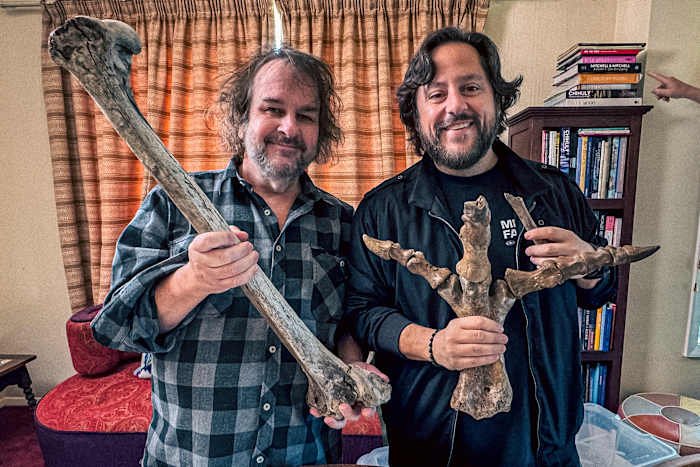
WASHINGTON— Filmmaker Peter Jackson has among the biggest personal collections of bones of a vanished New Zealand bird called the moa. His attraction with the flightless ostrich-like bird has actually resulted in an uncommon collaboration with a biotech firm understood for its grand and debatable strategies to revive shed varieties.
On Tuesday, Colossal Biosciences introduced an initiative to genetically craft living birds to look like the vanished South Island huge moa– which as soon as stood 12 feet (3.6 meters) high– with $15 million in financing from Jackson and his companion Fran Walsh. The partnership likewise consists of the New Zealand-based Ngāi Tahu Research Study Centre.
” The films are my day task, and the moa are my enjoyable point I do,” stated Jackson. “Every New Zealand schoolchild has an attraction with the moa.”
Outside researchers claim the concept of reviving vanished varieties onto the contemporary landscape is most likely difficult, although it might be viable to fine-tune the genetics of living pets to have comparable physical attributes. Researchers have actually blended sensations on whether that will certainly be handy, and some stress that concentrating on shed animals might sidetrack from shielding varieties that still exist.
The moa had actually strolled New Zealand for 4,000 years till they came to be vanished around 600 years back, mostly as a result of overhunting. A big skeletal system offered England in the 19th century, currently on display screen at the Yorkshire Gallery, motivated worldwide rate of interest in the long-necked bird.
Unlike Colossal’s deal with alarming wolves, the moa task remains in really onset. It began with a call concerning 2 years back after Jackson found out about the firm’s initiatives to “de-extinct”– or produce genetically comparable pets to– varieties like the woolly monstrous and the alarming wolf.
Then Jackson placed Colossal in contact with specialists he would certainly fulfilled via his very own moa bone-collecting. Then, he would certainly collected in between 300 and 400 bones, he stated.
In New Zealand, it’s lawful to deal moa bones discovered on personal lands, yet out public sanctuary– neither to export them.
The initial stage of the moa task will certainly be to recognize unspoiled bones where it might be feasible to remove DNA, stated Colossal’s primary researcher Beth Shapiro.
Those DNA series will certainly be contrasted to genomes of living bird varieties, consisting of the ground-dwelling tinamou and emu, “to determine what it is that made the moa one-of-a-kind contrasted to various other birds,” she stated.
Colossal utilized a comparable procedure of contrasting old DNA of vanished alarming wolves to establish the hereditary distinctions with grey wolves. After that researchers took blood cells from a living grey wolf and utilized CRISPR to genetically customize them in 20 various websites. Dogs with lengthy white hair and muscle jaws were birthed late in 2015.
Working with birds provides various difficulties, stated Shapiro.
Unlike animals, bird embryos establish inside eggs, so the procedure of moving an embryo to a surrogate will certainly not look like animal IVF.
” There’s great deals of various clinical obstacles that require to be gotten rid of with any kind of varieties that we choose as a prospect for de-extinction,” stated Shapiro. “We remain in the really onset.”
If the Colossal group is successful in producing a high bird with significant feet and thick sharp claws appearing like the moa, there’s likewise journalism inquiry of where to place it, stated Battle each other College environmentalist Stuart Pimm, that is not associated with the task.
” Can you place a varieties back right into the wild as soon as you’ve annihilated it there?” he stated. “I believe it’s exceptionally not likely that they might do this in any kind of purposeful method.”
” This will certainly be an exceptionally hazardous pet,” Pimm included.
The instructions of the task will certainly be formed by Māori scholars at the College of Canterbury’s Ngāi Tahu Study Centre. Ngāi Tahu excavator Kyle Davis, a specialist in moa bones, stated the job has actually “actually revitalized the rate of interest in analyzing our very own practices and folklore.”
At among the historical sites that Jackson and Davis checked out to research moa stays, called Pyramid Valley, there are likewise antique rock art done by Māori individuals– some illustrating moa prior to their termination.
Paul Scofield, a job advisor and elderly manager of nature at the Canterbury Gallery in Christchurch, New Zealand, stated he initially fulfilled the “Lord of the Rings” supervisor when he mosted likely to his residence to aid him identification which of the 9 recognized varieties of moa the numerous bones stood for.
” He does not simply accumulate some moa bones– he has an extensive collection,” stated Scofield.
___
The Associated Press Wellness and Scientific research Division gets assistance from the Howard Hughes Medical Institute’s Scientific research and Educational Media Team and the Robert Timber Johnson Structure. The AP is exclusively in charge of all material.
Copyright 2025 The Associated Press. All legal rights scheduled. This product might not be released, program, revised or rearranged without approval.



